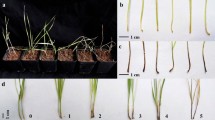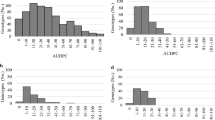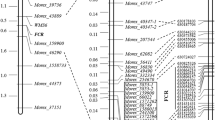Abstract
Crown rot of wheat and barley is a serious disease caused by the fungus Fusarium pseudograminearum, a stubble-borne pathogen common in no-till farming systems in water-limited grain growing regions. Marker assisted recurrent selection (MARS) was used to more effectively pyramid minor genes controlling plant response to crown rot disease. Two populations comprising 475 genotypes were phenotyped for adult plant resistance and genotyped using a 9K SNP array. A genome-wide association study (GWAS) was used to estimate quantitative trait locus (QTL) effects as more than two parents were recombined in each population. A total of 23 significant and unique marker-trait associations (MTAs) were identified in both populations. A Kompetitive allele-specific PCR (KASP) assay was developed and used to genotype the progeny and parents of each recombination cycle. Following two cycles of recombination among progeny, up to 22 markers of a possible 23 were recombined. Two hundred ninety-seven double haploid-derived lines representing both cycles of recombination, the original parents, parents selected from the base population and local cultivars were evaluated for crown rot resistance in 2016 and 2017 in the field under crown rot inoculation pressure. A significant and positive response to each cycle of recurrent selection was observed. MARS was an effective breeding strategy for combining many QTLs of small effect for crown rot resistance in wheat.




Similar content being viewed by others
References
Allard R (1960) Principles of plant breeding. Wiley, New York, pp 92–98
Bansal UK, Kazi AG, Singh B, Hare RA, Bariana HS (2014) Mapping of durable stripe rust resistance in a durum wheat cultivar Wollaroi. Mol Breed 33:51–59
Bernardo R, Charcosset A (2006) Usefulness of gene information in marker-assisted recurrent selection: a simulation appraisal. Crop Sci 46:614–621
Bovill W, Ma W, Ritter K, Collard B, Davis M, Wildermuth G, Sutherland M (2006) Identification of novel QTL for resistance to crown rot in the doubled haploid wheat population ‘W21MMT70’בMendos’. Plant Breed 125:538–543
Bovill W, Horne M, Herde D, Davis M, Wildermuth G, Sutherland M (2010) Pyramiding QTL increases seedling resistance to crown rot (Fusarium pseudograminearum) of wheat (Triticum aestivum). Theor Appl Gene 121:127–136
Burgess LW, Bently AR, Purss GS, Wildermuth GB, Doman RL (2012) Crown rot of wheat and Barly caused by Fusarium pseudograminearum: a stress related disease. First international crown rot workshop for wheat improvement, Narrabri, NSW, Australia
Cavanagh CR, Chao S, Wang S, Huang BE, Stephen S, Kiani S, Forrest K, Saintenac C, Brown-Guedira GL, Akhunova A (2013) Genome-wide comparative diversity uncovers multiple targets of selection for improvement in hexaploid wheat landraces and cultivars. Proc Natl Acad Sci 110:8057–8062
Chakraborty S, Liu C, Mitter V, Scott J, Akinsanmi O, Ali S, Dill-Macky R, Nicol J, Backhouse D, Simpfendorfer S (2006) Pathogen population structure and epidemiology are keys to wheat crown rot and Fusarium head blight management. Aust Plant Pathol 35:643–655
Collard B, Grams R, Bovill W, Percy C, Jolley R, Lehmensiek A, Wildermuth G, Sutherland M (2005) Development of molecular markers for crown rot resistance in wheat: mapping of QTLs for seedling resistance in a ‘2-49’בJanz’population. Plant Breed 124:532–537
Crossa J, Burgueno J, Dreisigacker S, Vargas M, Herrera-Foessel SA, Lillemo M, Singh RP, Trethowan R, Warburton M, Franco J (2007) Association analysis of historical bread wheat germplasm using additive genetic covariance of relatives and population structure. Genetics 177:1889–1913
Daetwyler HD, Bansal UK, Bariana HS, Hayden MJ, Hayes BJ (2014) Genomic prediction for rust resistance in diverse wheat landraces. Theor Appl Genet 127(8):1795–1803
Diaz-Lago JE, Stuthman DD, Abadie TE (2002) Recurrent selection for partial resistance to crown rust in oat. Crop Sci 42(5):1475–1482
Fehr WR (1987) Principles of cultivar development. In: Theory and technique, vol 1. Macmillan Publishing Company, New York
Garcia M, Eckermann P, Haefele S, Satija S, Sznajder B, Timmins A, Baumann U, Wolters P, Mather DE, Fleury D (2019) Genome-wide association mapping of grain yield in a diverse collection of spring wheat (Triticum aestivum L.) evaluated in southern Australia. PLoS ONE 14(2):e0211730. https://doi.org/10.1371/journal.pone.0211730
Golkari S, Gilbert J, Slusarenko K, Fernando WGD, Brûlé-Babel A (2008) Effect of rotation on colonization of field stubble by Fusarium species. Cereal Res Commun 36:555–561
Jain N, Singh G, Singh P, Ramya P, Krishna H, Ramya K, Todkar L, Amasiddha B, Kumar K, Vijay P (2014) Molecular approaches for wheat improvement under drought and heat stress. Indi J Gene and Plant Breed 74:578–583
Johnson H, Comstock R, Harvey P (1951) Genotypic and phenotypic correlations in corn and their implications in selection. Agron J 43:282–287
Johnson C, Khan A, Kilian A, Huttner E, Falk D (2005) Fundamentals of plant breeding and early-stage genetic testing. A cereal chemist’s quick guide to genetics. Plant Breed BiolT:27–44
Klein T, Summerell B, Burgess L (1988) Influence of stubble-management practices on crown rot of wheat. Plant Protection Quarterly (Australia)
Korte A, Farlow A (2013) The advantages and limitations of trait analysis with GWAS: a review. Plant Methods 9:29. https://doi.org/10.1186/1746-4811-9-29
Liu C, Ogbonnaya FC (2015) Resistance to Fusarium crown rot in wheat and barley: a review. Plant Breed 134:365–372
MacLeod B (2008) Root disease under intensive cereal production systems. http://archive.agric.wa.gov.au/objtwr/imported_assets/content/fcp/cer/bulletin_cerealrootdis07.pdf
Maluszynski M, Kasha K, Forster B, Szarejko I (2013) Doubled haploid production in crop plants: a manual. Springer Science & Business Media, Berlin
Martin A, Bovill W, Percy C, Herde D, Fletcher S, Kelly A, Neate S, Sutherland M (2015) Markers for seedling and adult plant crown rot resistance in four partially resistant bread wheat sources. Theor Appl Gene 128:377–385
Mascher M, Muehlbauer GJ, Rokhsar DS, Chapman J, Schmutz J, Barry K, Munoz-Amatriain M, Close TJ, Wise RP, Schulman AH (2013) Anchoring and ordering NGS contig assemblies by population sequencing (POPSEQ). Plant J 76(4):718–727
Milgate A (2013) Wheat variety reponses to crown rot in southern NSW. http://www.grdc.com.au/uploads/documents/GRDC_CrownRot_SthWest.pdf.Visit@17.8.2014
Monds R, Cromey M, Lauren DR, di Menna M, Marshall J (2005) Fusarium graminearum, F. cortaderia and F. pseudograminearum in New Zealand: molecular phylogenetic analysis, mycotoxin chemotypes and co-existance of species. Mycol Res 109:410–420
Mudge AM, Dill-Macky R, Dong Y, Gardiner DM, White RG, Manners JM (2006) A role for the mycotoxin deoxynivalenol in stem colonisation during crown rot disease of wheat caused by Fusarium graminearum and Fusarium pseudograminearum. Physiol Mol Plant Pathol 69:73–85
Murray GM, Brennan JP (2009) Estimating disease losses to the Australian wheat industry. Aust Plant Pathol 38:558–570
Neumann K, Kobiljski B, Denčić S, Varshney R, Börner A (2011) Genome-wide association mapping: a case study in bread wheat (Triticum aestivum L.). Mol Breed 27:37–58
Nicol J, Dababat A, Erginbas G, Bolat N, Yorgincilar A, Tunalig B, Bagci S, Hekimham H, Ozdemir F, Morgounov A, Manes Y, Shingh R, Barun H, Trethowan R (2012) An international perspective on CIMMYT-Turkey research on Fusarium crown rot of wheat-progress and future perspective with reference to Australian germplasm improvement. 1st international crown rot workshop for wheat improvement, Narrabri, NSW, Australia
Pasam RK, Bansal U, Daetwyler HD, Forrest KL, Wong D, Petkowski J, Willey N, Randhawa M, Chhetri M, Miah H (2017) Detection and validation of genomic regions associated with resistance to rust diseases in a worldwide hexaploid wheat landrace collection using BayesR and mixed linear model approaches. Theor Appl Genet 130(4):777–793
Piepho HP, Möhring J (2007) Computing heritability and selection response from unbalanced plant breeding trials. Genetics 177:1881–1888
Poole G, Smiley R, Paulitz T, Walker C, Carter A, See D, Garland-Campbell K (2012) Identification of quantitative trait loci (QTL) for resistance to Fusarium crown rot (Fusarium pseudograminearum) in multiple assay environments in the Pacific Northwestern US. Theor Appl Genet 125:91–107
Posadas LG, Eskridge KM, Specht JE, Graef GL (2014) Elite performance for grain yield from unadapted exotic soybean germplasm in three cycles of a recurrent selection experiment. Crop Sci 54:2536–2546
Simpfendorfer S (2012) Crown rot of wheat and Barly caused by Fusarium pseudograminearum: a stress related disease first international crown rot workshop for wheat improvement, Narrabri, NSW, Australia
Simpfendorfer A, Kirkegaard B, Holland A, Verrell A, Bambach A, Moore K (2006) Managing soil and stubble-borne cereal pathogens in the northern grains belt, A NSW Department of Primary Industries, Tamworth Agricultural Institute, NSW 2340, https://www.adelaide.edu.au/css/newsletters/archive/2000s/StubblePath_2006.pdf.Visit@26.12.2014
Smiley RW, Gourlie JA, Easley SA, Patterson LM, Whittaker RG (2005) Crop damage estimates for crown rot of wheat and barley in the Pacific Northwest. Plant Dis 89:595–604
Swan L, Backhouse D, Burgess L (2000) Surface soil moisture and stubble management practice effects on the progress of infection of wheat by Fusarium pseudograminearum. Anim Prod Sci 40:693–698
Vales M, Dossmann J, Delgado D, Duque MC (2009) Parallel and interlaced recurrent selection (PAIRS): demonstration of the feasibility of implementing PAIRS to improve complete and partial resistance to blast (Magnaporthe grisea) and some other main traits in rice. Field Crop Res 111:173–178
Wallwork H, Butt M, Cheong J, Williams K (2004) Resistance to crown rot in wheat identified through an improved method for screening adult plants. Australas Plant Pathol 33(1):1–7
Wang S, Wong D, Forrest K, Allen A, Chao S, Huang BE, Maccaferri M, Salvi S, Milner SG, Cattivelli L (2014) Characterization of polyploid wheat genomic diversity using a high-density 90 000 single nucleotide polymorphism array. Plant Biotechnol J 12:787–796
Wiersma JJ, Busch RH, Fulcher GG, Hareland GA (2001) Recurrent selection for kernel weight in spring wheat. Crop Sci 41:999–1005
Wildermuth G, Thomas G, Radford B, McNamara R, Kelly A (1997) Crown rot and common root rot in wheat grown under different tillage and stubble treatments in southern Queensland, Australia. Soil Tillage Res 44:211–224
Wildermuth G, McNamara R, Quick J (2001) Crown depth and susceptibility to crown rot in wheat. Euphytica 122(2):397–405
Yang J, Lee SH, Goddard ME, Visscher PM (2011) GCTA: a tool for genome-wide complex trait analysis. Am J Hum Genet 88(1):76–82
You FM, Huo N, Gu YQ, Luo M, Ma Y, Hane D, Lazo GR, Dvorak J, Anderson OD (2008) BatchPrimer3: a high throughput web application for PCR and sequencing primer design. BMC Bioinformatics 9(1):253
Young N, Tanksley S (1989) RFLP analysis of the size of chromosomal segments retained around the Tm-2 locus of tomato during backcross breeding. Theor Appl gene 77:353–359
Funding
The authors acknowledge the assistance of the Grains Research and Development Corporation for funding this project, along with the Australian Centre for International Agricultural Research for a student scholarship for the lead author.
Author information
Authors and Affiliations
Corresponding author
Ethics declarations
Conflict of interest
The authors declare that they have no conflict of interest.
Ethical standards
All of the authors have read and have abided by the statement of ethical standards for manuscripts submitted to Molecular Breeding.
Additional information
Publisher’s note
Springer Nature remains neutral with regard to jurisdictional claims in published maps and institutional affiliations.
Electronic supplementary material
ESM 1
(DOCX 42 kb)
Rights and permissions
About this article
Cite this article
Rahman, M., Davies, P., Bansal, U. et al. Marker-assisted recurrent selection improves the crown rot resistance of bread wheat. Mol Breeding 40, 28 (2020). https://doi.org/10.1007/s11032-020-1105-1
Received:
Accepted:
Published:
DOI: https://doi.org/10.1007/s11032-020-1105-1




